- What Is The EBITDA in Simple Terms?
- How to Calculate EBITDA?
- EBITDA vs Other Financial Metrics
- Analyzing EBITDA in Financial Context
- Top 6 Financial Ratios Involving EBITDA
- Limitations and Criticisms of EBITDA
- Manage Business Finances Smarter with InvoPilot
- Final Thoughts: Why EBITDA Still Matters for Your Business
Ever wonder how profitable a business really is—without all the extra noise like taxes or debt payments? That’s where EBITDA comes in.
Short for Earnings Before Interest, Taxes, Depreciation, and Amortization, it’s a mouthful, yes—but the idea behind it is simple. It shows how much a company earns from its main operations, ignoring costs that aren’t part of the day-to-day work (like loan interest or equipment wear and tear).
This guide simplifies EBITDA in a way that’s easy to understand. You’ll learn what it includes (and leaves out), how to calculate it, and why it’s such a popular number in business circles. We’ll also look at how it compares to other common metrics like EBIT and net income.
Whether you’re a startup owner, a student trying to figure out financial statements, or just someone curious about business numbers, this article will walk you through it—with clear examples, real-world uses, and zero fluff.
What Is The EBITDA in Simple Terms?
EBITDA (said as “ee-bit-dah”) is a common way banks check how well a business is doing. It shows how much a company earns before paying interest, taxes, and subtracting costs like depreciation and amortization.
EBITDA tells you how much money a business makes from just doing what it does every day. It doesn’t care about loan interest, taxes, or stuff like depreciation that accountants love but doesn’t touch real cash. Just pure operating profit.
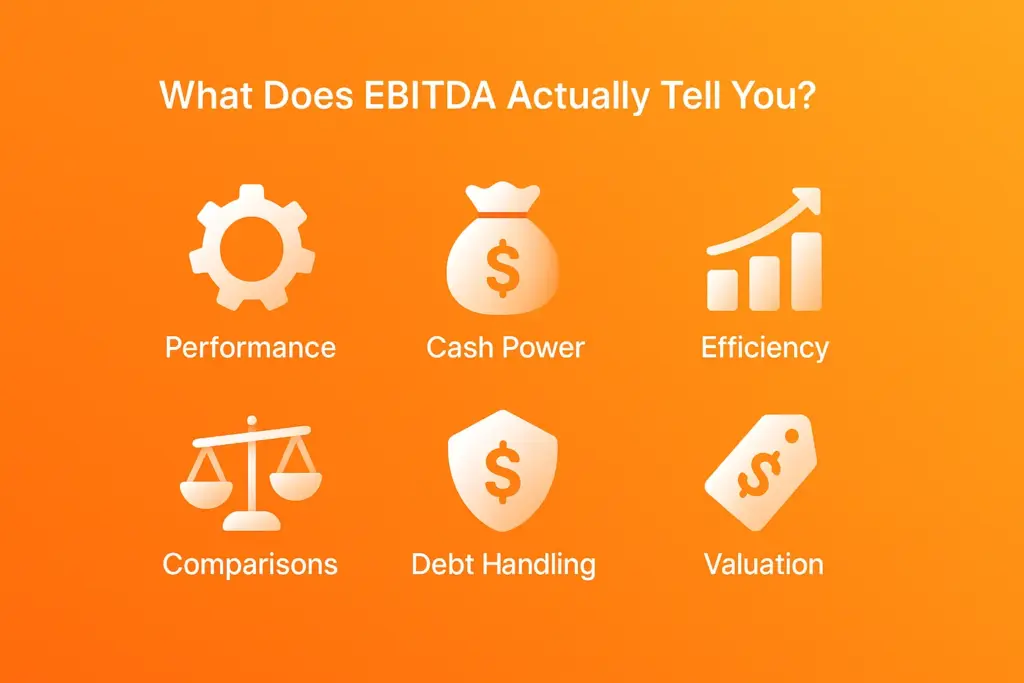
What Does EBITDA Actually Tell You?
You hear “EBITDA” a lot in business talk, but what’s the point of it? Honestly, it’s just a way to strip away the noise and see how the core business is really doing. Here’s what it shows:
1. It Shows How the Business Actually Performs
Instead of mixing in things like tax payments or how much money was borrowed, EBITDA focuses on operations. It doesn’t include interest, taxes, or paper-only expenses like depreciation. That way, you’re just looking at how well the business runs, not how it’s funded or taxed.
2. It Gives a Glimpse of Cash-Generating Power
Now, EBITDA isn’t the same as cash flow, but it gives you a rough idea of what the company might earn before paying interest or taxes. Since it leaves out non-cash stuff, it’s kind of like a shortcut for estimating potential cash from operations.
3. It Tells You If the Business Is Efficient
If a company’s EBITDA margin (that’s EBITDA divided by revenue) is high, it usually means the business is running smoothly and not burning too much money on overheads. Basically, more money is staying in the company instead of leaking out.
4. It Levels the Playing Field for Comparisons
Every industry plays by different rules. Some need tons of equipment, others don’t. Some pay more tax, some less. EBITDA cuts out all that noise and lets you compare businesses purely based on performance—apples to apples.
5. It Helps Check If a Company Can Handle Debt
When lenders want to know if a business can pay its debts, they often look at EBITDA. Why? Because it shows whether the business is earning enough to handle interest payments and loan repayments. A higher EBITDA usually means a safer bet for lenders.
6. It’s Used to Value Businesses Too
Ever heard of EV/EBITDA? That’s one of the common formulas used to figure out if a business is overvalued or a hidden gem. Investors use it all the time to compare companies—if the ratios are low, it might be a good deal.
History and Origin of EBITDA
You might think EBITDA is just another accounting term, but its origin actually has an interesting backstory. It started gaining traction in the 1970s, thanks to John Malone—yeah, the same media mogul behind Liberty Media. At the time, Malone was running companies that were piling on debt to grow fast. Traditional metrics didn’t do justice to how much actual money these companies were pulling in, so he needed a better way to show their earning strength. That’s where EBITDA came in.
The 1970s: A New Way to Look at Profit
Malone realized that if he stripped out interest payments, taxes, and the effects of things like depreciation, the numbers suddenly made more sense—especially when talking to investors or banks. Basically, he wanted to say: “Hey, ignore the accounting noise and just look at how much cash we’re really making from running the business.” And it worked. EBITDA helped make the case that his companies were more profitable than they looked on paper.
The 1980s: LBOs and the Rise of EBITDA
In the 1980s, private equity firms jumped on the EBITDA bandwagon. It became a key tool during leveraged buyouts (LBOs), where firms borrowed huge sums to buy companies. The question always came up: can this business handle all that debt? EBITDA helped answer that by focusing on raw earnings—before the financing and accounting tricks came into play.
Some Pushback Along the Way
But it hasn’t always been smooth sailing. During the dot-com bubble, some companies used EBITDA to paint a much rosier picture than reality. They ignored the huge costs and said, “Look, we’re doing great!” even when they weren’t. And then came creative versions like “Community Adjusted EBITDA” (remember WeWork?), which made things even murkier.
Today: Still Useful, But Not a Silver Bullet
Now, EBITDA is everywhere. It’s handy when comparing companies—especially if they’re in capital-heavy industries. But it’s not perfect. It ignores real costs like interest and capital spending. So yeah, it’s a useful metric, but if you rely only on it? You’re not getting the full picture.
What Are the Components of EBITDA?
EBITDA is a popular calculation in finance, often used by investors and analysts to understand how a business performs in the core – without being tangled in accounting tactics or financial strategies.
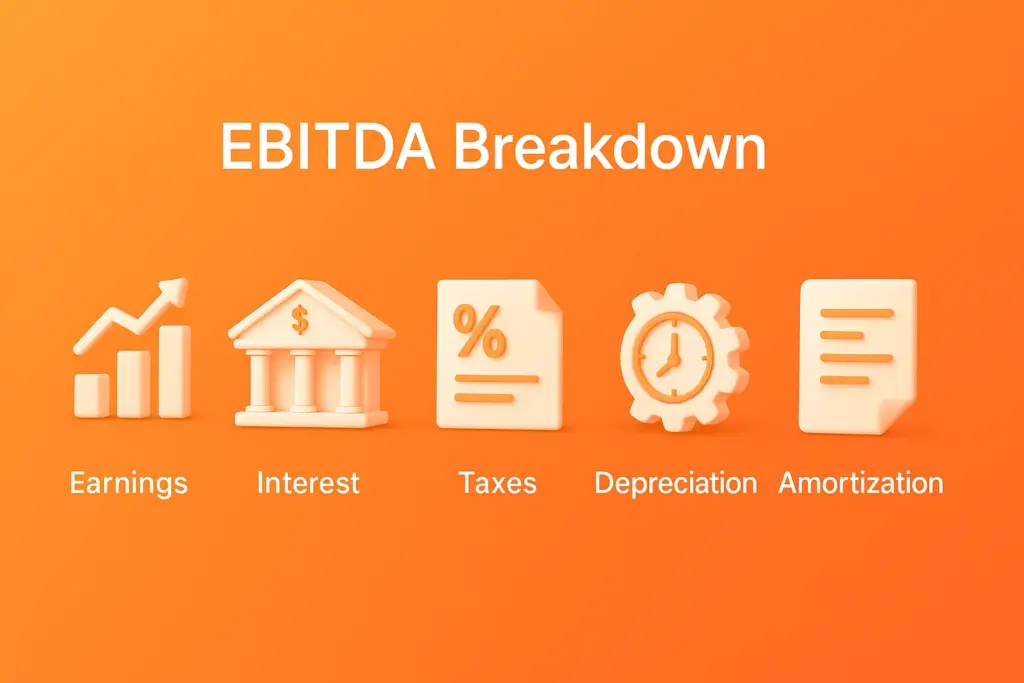
What does it go into? Let’s break down every component in a way that actually makes sense.
1. Earnings (Profit from Operations)
This is the base. We start with the company’s net income-in the starting point how much money it made from selling goods or services, before we deduct interest payments, taxes or non-accounting costs such as depreciation.
For example, if a business runs a chain of cafes, this will be the profits from these cafes before we worry about loans, state taxes or how their espresso machines lose their value over time.
2. Interest (Cost of Borrowing)
Most companies borrow money – whether it is a business loan, credit line or bonds issued to raise capital. Interest paid on these loans is an expense, but EBITDA ignores it.
Why? Because interest is not related to how effective the business runs. It reflects the company’s financing structure, not its operational strength.
3. Taxes (Government Dues)
Companies pay taxes based on where they operate and how much they earn. But tax policy differs widely between countries – and even across states. Since taxes can distort the image of a company’s actual performance, they are left out of the EBITDA formula.
Removing taxes makes it easier to compare two companies in different regions.
Also Check: What is Tax Invoice
4. Depreciation (Wear and Tear of Physical Assets)
Suppose a company buys machines worth 50 lakhs. Instead of processing the full amount as a one year cost, the accounting rules allow it “spread” over several years. That spread is called depreciation.
Depreciation does not involve cash leaving the company – it is just an accounting adjustment. EBITDA stripes this out to focus only on actual cash -based performance.
5. Amortization (Decline in Value of Intangible Assets)
Amortization is like depreciation, but for intangible assets. These include patents, copyrights, trademarks or even the value assigned to goodwill during procurement. They also lose value over time, and just as with depreciation, this loss is recorded gradually.
Again, it is not a cash expenditure – EBITDA removes it to stay focused on cash-generating activities.
Why Is EBITDA Considered a Non-GAAP Measure?
EBITDA is a common calculation used by companies and analysts to evaluate a company’s operating profit. Despite popularity, it does not fall under the framework of generally accepted accounting principles (GAAP), and here are the reasons.
1. Not Part of GAAP-Required Financials
GAAP publishes a specific structure for financial reporting, including necessary documents such as profit accounts, balance sheet and cash flow tasks. EBITDA is not one of them. In fact, GAAP does not define or requires EBITDA in any form. It is considered an additional measure – something companies choose to include often for internal analysis or investor presentations. Because it is not part of the formal reporting standards, EBITDA is not revised or reported in a steady way across companies.
2. No Single Way to Calculate It
One of the main reasons why EBITDA is classified as a non-GAAP measure is that there is no standard method to calculate it. While most definitions start with net income and return interest, taxes, depreciation and amortization, many companies refine the formula that suits their narrative. They can exclude non-operating items, one-off costs or even stock-based compensation. These variations can make EBITDA figures differ a lot between companies, even in the same sector.
3. Strips Away Non-Operational Costs
What draws many businesses to EBITDA is its ability to isolate operating results. By removing the effect of financing (interest), taxes and non-accounting fees such as depreciation and amortization, EBITDA aims to reflect the company’s core profitability. This can be useful for comparing companies that operate in different tax zones or have different capital structures. Nevertheless, it is important to recognize that these excluded costs are real-they affect the cash flow and long-term sustainability, even though they are temporarily set aside for analysis.
4. Must Be Reconciled with GAAP Figures
Because EBITDA is outside GAAP rules, U.S. Securities and Exchange Commission (SEC) that public companies show how it is connected to a GAAP metric, usually net income. This reconciliation is compulsory when EBITDA is included in income releases, investor reports or submissions of regulations. The goal is to give readers enough context to understand how the non-GAAP figure compares to the official economy.
Also Read: Invoice Reconciliation
How to Calculate EBITDA?
To calculate EBITDA, a company’s net income is adjusted by adding back interest, taxes, depreciation, and amortization expenses. This calculation gives a clear view of a company’s operating salary by excluding the effect of financing decisions, tax obligations and non-accounting expenses related to capital distributors.
EBITDA Formula with Explanation
EBITDA = Net Income + Interest + Taxes + Depreciation + Amortization
This formula reduces non-operating and non-accounting costs for net income, and gives a clearer view of a company’s operating salary. By excluding interest, taxes, depreciation and amortization, EBITDA emphasizes how much a company earns on its core business.
EBITDA Calculation – Step-by-Step
Follow these steps to calculate EBITDA using a company’s income statement:
Step 1: Start with Net Income
Locate the net income figure at the bottom of the income statement.
Step 2: Add Back Interest
Check for interest expenses, typically found above the tax section.
Step 3: Add Back Taxes
Add the income tax expense.
Step 4: Add Depreciation and Amortization
These are typically listed in the cash flow statement under ‘Adjustments for non-cash items’ or disclosed in the notes to the financial statements.
Step 5: Sum It All Up
Add all the values together to get EBITDA.
Shortcut: If available, you can also calculate: EBITDA = Operating Income (EBIT) + Depreciation + Amortization
Example of EBITDA Calculation
Let’s say you’re analyzing the financial performance of a company called GreenTech Solutions Pvt. Ltd., a mid-sized manufacturer of solar panels.
Here’s a simplified version of their Income Statement for the year ending March 31, 2025:
| Particulars | Amount (INR) |
| Revenue (Sales) | ₹8,00,00,000 |
| Cost of Goods Sold (COGS) | ₹3,50,00,000 |
| Gross Profit | ₹4,50,00,000 |
| Operating Expenses: | |
| – Salaries & Wages | ₹90,00,000 |
| – Rent | ₹20,00,000 |
| – Marketing & Advertising | ₹15,00,000 |
| – Utilities and Admin Expenses | ₹10,00,000 |
| EBITDA (to be calculated) | ? |
| Depreciation | ₹18,00,000 |
| Amortization | ₹5,00,000 |
| Operating Profit (EBIT) | ₹2,92,00,000 |
| Interest Expense | ₹25,00,000 |
| Taxes | ₹80,00,000 |
| Net Profit | ₹1,87,00,000 |
Step-by-Step EBITDA Calculation
Step 1: Start with Operating Profit (EBIT): Operating Profit = ₹2,92,00,000
Step 2: Add Back Depreciation and Amortization: Depreciation = ₹18,00,000 and Amortization = ₹5,00,000
EBITDA = EBIT + Depreciation + Amortization
EBITDA = ₹2,92,00,000 + ₹18,00,000 + ₹5,00,000
EBITDA = ₹3,15,00,000
Final Answer: EBITDA for GreenTech Solutions Pvt. Ltd. = ₹3.15 Crores
Why Are Depreciation and Amortization Added Back?
Depreciation and amortization are added back in EBITDA because they are non-cash expenses. These costs reduce a company’s accounting profit but do not involve actual cash flowing during the period. Depreciation typically represents the gradual reduction in value of tangible assets like machinery, while amortization applies to intangible assets like patents or software. Since EBITDA aims to measure a company’s core operational results without the impact of financing decisions, tax structures, or accounting methods. These non-accounting taxes provide a clearer picture of the company’s ability to generate cash from the operation.
What Does Amortization Mean in EBITDA?
Amortization in the context of EBITDA refers to gradual expenses for intangible assets – such as patents, copyrights, trademarks or goodwill – over their lifetime. These are non-cash accounting listings that reduce the value of intangible assets in the balance sheet over time. When calculating EBITDA, amortization is added back to net income because it is a non-operating, non-accountant expenditure. This adjustment helps to present a clearer picture of a company’s core surgery performance by excluding the effect of accounting practices related to intangible assets. Essentially, EBITDA aims to reflect the profitability of the company’s activities without the influence of invoice financing decisions, tax strategies or historical investments in assets.
EBITDA vs Other Financial Metrics
EBITDA vs EBIT vs EBT
| Metric | Stands For | Formula | Includes Depreciation & Amortization | Includes Interest | Includes Taxes | Profitability Level Shown |
| EBITDA | Earnings Before Interest, Taxes, Depreciation, and Amortization | Net Income + Interest + Taxes + Depreciation + Amortization | No | No | No | Operating profitability (pure) |
| EBIT | Earnings Before Interest and Taxes | Net Income + Interest + Taxes | Yes | No | No | Operating profit (after non-cash) |
| EBT | Earnings Before Taxes | Net Income + Taxes | Yes | Yes | No | Profit before tax |
EBITDA vs Operating Cash Flow
| Metric | What It Measures | Includes Working Capital Changes | Cash-Based? | Use Case |
| EBITDA | Profit before non-cash and non-operating expenses | No | No | Compare core profitability |
| Operating Cash Flow | Actual cash generated from operations | Yes | Yes | Cash availability for operations |
EBITDA vs Net Income
| Metric | Definition | Includes Interest & Taxes | Includes Non-Operating Items | Cash-Based? | Use Case |
| EBITDA | Profit before interest, tax, depreciation, amortization | No | No | No | Evaluate core operating performance |
| Net Income | Final profit after all expenses, interest, taxes, etc. | Yes | Yes | No | Assess shareholder returns |
Is EBITDA the Same as Gross Profit?
No, EBITDA is not the same as Gross Profit.
Gross Profit represents the earnings left after subtracting the cost of goods sold from total revenue. It only considers direct production costs, such as materials and labor, and excludes operating expenses like rent, salaries, depreciation, etc.
EBITDA, on the other hand, includes all operating income before deducting interest, taxes, depreciation, and amortization. It reflects broader operating performance, whereas Gross Profit focuses strictly on production efficiency.
Difference Between EBITDA and EBITA
| Metric | Stands For | Includes Depreciation | Includes Amortization | Purpose |
| EBITDA | Earnings Before Interest, Taxes, Depreciation, and Amortization | No | No | Show total core profitability |
| EBITA | Earnings Before Interest, Taxes, and Amortization | Yes | No | Focus on tangible asset efficiency |
Analyzing EBITDA in Financial Context
EBITDA in Financial Context is like a spotlight on a company’s true business strength. It shows how much profit a company makes from its core operations, without getting blurred by loan costs, tax payments, or accounting adjustments like depreciation and amortization.
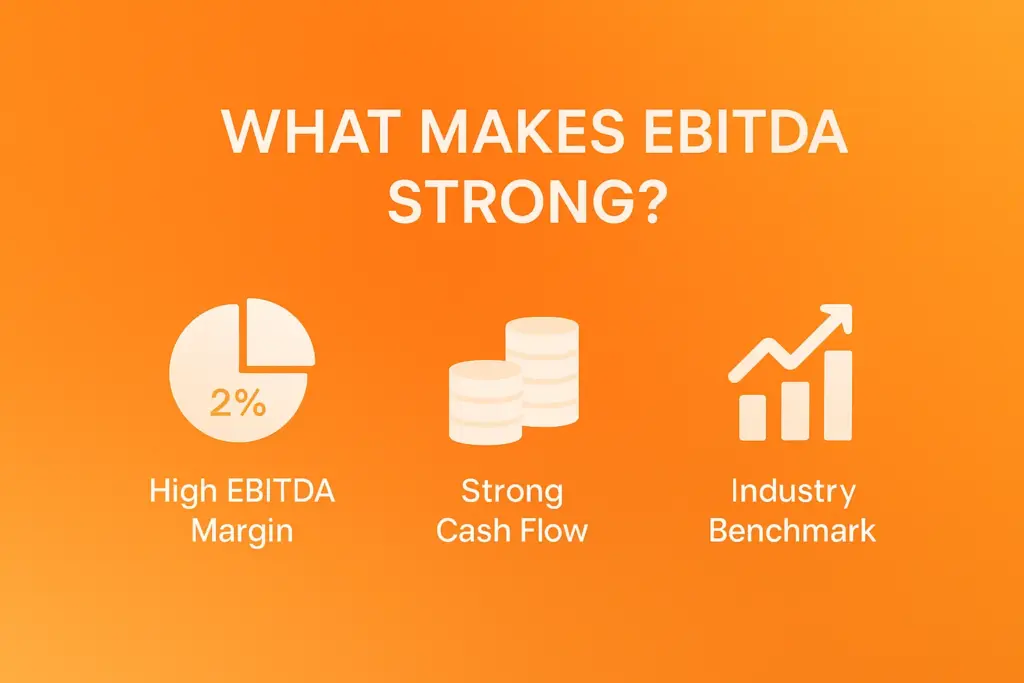
What Is a Good EBITDA?
A good EBITDA (Earnings Before Interest, Taxes, Depreciation, and Amortization) means that a company earns strong profits from its core business.
But what counts as “good” can vary depending on industry, corporate size and business model. Generally:
Higher EBITDA usually means that the company is doing well and generates healthy cash flow.
A good EBITDA margin (EBITDA as a percentage of revenue) is often 10% or more. This means that the company holds at least ₹ 10 in profits (before interest, taxes, etc.) for every ₹ 100 it earns in revenue.
Compared to competitors: If EBITDA is better than others in the same industry, that’s a good sign.
Think about it this way:
A good EBITDA shows that a business earns well before they pay for loans, taxes and equipment costs – it’s like checking how strong the engine is before you look at fuel costs or road conditions.
What Is EBITDA Multiple and Why Does It Matters?
EBITDA Multiple is a tool that helps people figure out how much a company is worth. It compares the value of a business to its EBITDA.
In simple terms, it’s like asking: “How many times the company’s earnings would someone be willing to pay to buy it?”
The Basic Formula is: EBITDA Multiple = Company Value ÷ EBITDA
For example, if a company is worth ₹50 crore and its EBITDA is ₹10 crore, the EBITDA multiple is 5x. This means buyers are willing to pay 5 times the company’s EBITDA to own it. It matters because –
- It Helps Value Companies: Investors and buyers use EBITDA multiple to judge if a business is cheap or expensive compared to others.
- It is Useful for Comparisons: It allows you to compare companies across the same industry, even if they’re different in size.
- It Strips Out Non-Core Costs: Since EBITDA removes interest, tax, depreciation, and amortization, it gives a clearer picture of the business’s core operations.
- It Supports Better Decisions: Buyers, sellers, and investors use it to make smarter choices during mergers, acquisitions, or funding rounds.
Significance of EBITDA in Business Valuation
EBITDA plays an important role when determining the value of a business. It matters in Business Valuation a lot because it –
1. Highlighting the Daily Profitability
EBITDA removes the effects of things like loan interest, taxes, and non-cash expenses (such as depreciation). This lets you see how well a company runs its basic operations.
2. Make the Comparison Easier
Since it omits costs that vary from one business to another – such as debt or local taxes – it helps investors to compare companies more fairly, even in different industries or countries.
3. Shows the Opportunity to Handle Debt
Lenders often check EBITDA to understand if a company can repay the loans. A higher EBITDA usually means that the company has more income available to fulfill the debt obligations.
4. Regular Tool for Valuation
Investors often use EBITDA as a base to estimate what a business is worth. They use a valuation multiple (like 5x or 10x eBitda) to get an impression of how much the company can sell for.
5. Indicates Business Strength
EBITDA provides insight into a company’s performance without noise from outside factors. This makes it a good way to measure economic health and profitability from core business activities.
Top 6 Financial Ratios Involving EBITDA
To dig deeper into a company’s financial health, we use EBITDA-based financial ratios. These ratios help measure profitability, efficiency, debt capacity, and overall valuation. Let’s break down the six most important financial ratios involving EBITDA.
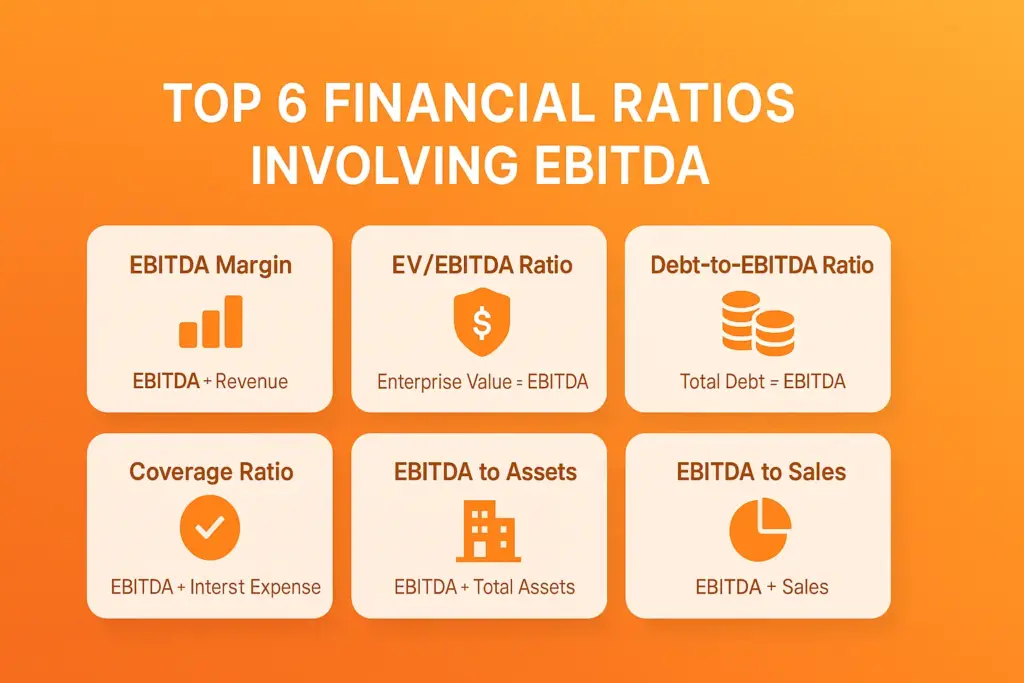
1. EBITDA Margin
EBITDA Margin shows how much profit a company makes from its operations for every dollar of revenue. It helps evaluate operating efficiency before financial and accounting factors are considered.
EBITDA Margin = (EBITDA ÷ Total Revenue) × 100
Example: If a company earns $800,000 in revenue and has an EBITDA of $200,000:
EBITDA Margin = ($200,000 ÷ $800,000) × 100 = 25%
It is very important because it indicates how much operating income is retained from sales. A higher margin reflects efficient cost control. It helps compare how profitable different companies or industries are, no matter how they’re funded or what taxes they pay.
2. EBITDA Coverage Ratio
This ratio tells how comfortably a company can pay its interest costs using the money it earns before paying interest, taxes, and other expenses. It assesses debt servicing capacity.
Formula: EBITDA Coverage Ratio = EBITDA ÷ Interest Expense
Example: Let’s say a company has EBITDA = $400,000 and Interest Expense = $100,000
EBITDA Coverage = $400,000 ÷ $100,000 = 4.0
It is important because a ratio of 4 means the company earns four times more than its interest obligations. Higher ratios means lower risk of default and lenders and investors use it to assess creditworthiness and financial stability.
3. EV/EBITDA Ratio (Enterprise Value to EBITDA)
This ratio compares a company’s total value (Enterprise Value) to its EBITDA. It’s a valuation tool used in mergers, acquisitions, and investment analysis.
Formula: EV/EBITDA = Enterprise Value ÷ EBITDA
Enterprise Value (EV) = Market Cap + Debt – Cash
Example: If a company has Market Capitalization: $5M, Debt: $2M, Cash: $1M and EBITDA: $1M
Then, EV = $5M + $2M – $1M = $6M
EV/EBITDA = $6M ÷ $1M = 6x
It is Important because a lower EV/EBITDA may indicate undervaluation. It helps compare companies across industries regardless of capital structure. It is commonly used by private equity investors and analysts.
4. Debt-to-EBITDA Ratio
This ratio tells us how long a company would take to repay all its debts if it used 100% of its EBITDA. It’s a leverage and solvency indicator.
Formula: Debt-to-EBITDA = Total Debt / EBITDA
Example: Total Debt = $3,000,000 and EBITDA = $1,000,000
Debt-to-EBITDA = 3.0
It is Important because lower ratios show manageable debt levels. A ratio above 4–5 may indicate excessive leverage and it is used by credit rating agencies and banks to evaluate risk.
5. EBITDA to Total Assets Ratio
This ratio shows how well a company is using all its assets to make money from its core business. It connects asset utilization with profitability.
Formula: EBITDA to Total Assets = EBITDA ÷ Total Assets
Example: EBITDA = $750,000 and Total Assets = $5,000,000
EBITDA to Assets = 0.15 or 15%
This ratio is important because it highlights how efficiently a company’s assets generate operating earnings. It’s especially valuable for capital-intensive industries and helps identify underperforming assets or poor resource utilization.
6. EBITDA to Sales Ratio (Similar to EBITDA Margin)
While very similar to EBITDA Margin, this ratio may be calculated using net sales instead of total revenue. It reflects profit generated from every dollar of sales.
Formula: EBITDA to Sales = EBITDA ÷ Net Sales
Example: EBITDA = $500,000 and Net Sales = $2,500,000
EBITDA to Sales = 0.20 or 20%
It is Important because it indicates core operating efficiency. It helps measure profitability from sales without the impact of taxes and depreciation and it is easier to compare among companies with varying financial structures.
| Ratio | What It Measures | Formula | Ideal Use |
| EBITDA Margin | Operating profit as % of revenue | EBITDA ÷ Revenue × 100 | Compare operating efficiency |
| EBITDA Coverage Ratio | Ability to pay interest | EBITDA ÷ Interest Expense | Assess debt servicing capability |
| EV/EBITDA | Company valuation | Enterprise Value ÷ EBITDA | Measure market valuation |
| Debt-to-EBITDA | Debt load relative to earnings | Total Debt ÷ EBITDA | Evaluate financial leverage |
| EBITDA to Total Assets | Asset productivity | EBITDA ÷ Total Assets | Measure asset efficiency |
| EBITDA to Sales | Profit from sales (alternative to margin) | EBITDA ÷ Net Sales | Track sales profitability |
Limitations and Criticisms of EBITDA
While EBITDA is a widely used financial calculation to evaluate a company’s operating profit, it is not without limitations. To rely solely on EBITDA can sometimes present a misleading picture of a company’s financial health. Below are some of the most important criticisms and disadvantages associated with this measure.
Common Disadvantages of EBITDA
1. Ignores Capital Expenditures
EBITDA excludes capital expenses (CapEx), which is crucial to maintain and grow a business. For capital -intensive industries such as production or tools, ignoring CapEx can distort the real operating costs.
2. Excludes Changes in Working Capital
EBITDA does not stand for changes in working capital – for example, an increase in accounts receivable or fixtures – which may affect the cash flow. A company can report strong EBITDA, but still struggles with liquidity due to ineffective management of working capital.
3. Non-GAAP Nature
Since EBITDA is a non-GAAP calculation, companies have a discretion in how they calculate it. This lack of standardization can make it difficult to compare EBITDA figures across different companies or industries.
4. Can Mask Financial Problems
By omitting interest rates, taxes, depreciation and amortization, EBITDA can sometimes be used to mask underlying economic problems such as high debt levels or poor asset management.
5. Overemphasis on Operational Profitability
EBITDA focuses on core operating results, but ignores critical economic realities such as financing costs and tax obligations. This can exaggerate the profitability, especially for companies with high utilization or operations in high tax jurisdictions.
Criticisms by Analysts and Investors
1. Misleading Indicator of Cash Flow
Some analysts claim that EBITDA is often mistaken for a power of cash flow, although it does not reflect actual cash available to shareholders or creditors. It excludes important outputs such as interest payments and taxes, which are real and recurrent.
2. Potential for Earnings Manipulation
Because EBITDA excludes certain costs, it can be manipulated to present a more favorable image. For example, management may highlight adjusted EBITDA numbers that exclude various “non-recurring” expenses, leading to inflated perception of profitability.
3. Insufficient for Valuation Alone
Investors warn against using EBITDA isolated for the company’s valuation. It should be supplemented with other calculations such as free cash flow, net income and return on equity to get a well -rounded view of financial results.
4. Less Relevant in Service-Based Sectors
In industries with low capital intensity, such as software or counseling, EBITDA can provide limited insight. Other profitability calculations can better reflect operational efficiency in such cases.
Manage Business Finances Smarter with InvoPilot
Knowing what EBITDA means is just the beginning. If you want to make financial insight into real business growth, you need the right tools – and that’s where Invopilot can help.
Whether you’re a freelancer, startup, or growing business, InvoPilot gives you everything you need to manage your money like a pro:
- Create invoices instantly – Look professional and get paid faster
- Track payments and cash flow – Stay on top of what you’re owed
- Use smart insights – Make better decisions with real-time financial data
- Save time and reduce errors – Focus more on growing your business, not paperwork
Don’t just understand your numbers—own them. With InvoPilot, you can simplify your finances, increase profitability, and feel confident in every business move you make.
Try InvoPilot for free today and start managing your business smarter!
Final Thoughts: Why EBITDA Still Matters for Your Business
EBITDA is not just another financial term – it is a smart way to understand how well a business really does. By removing the effect of taxes, interest payments, depreciation and amortization, EBITDA focuses only on a company’s core business. Simply put, it tells you how much money a business earns on its daily activities-out financial distractions.
This makes EBITDA a useful tool when comparing different companies, checking how much debt a business can manage, or finding out how strong the surplus is. It gives you a clearer picture of performance than just looking at net income or revenue alone.
But here is the catch: EBITDA should not be the only number you trust. Although it is great for analysis, it does not tell the whole story. It is important to use EBITDA with other financial conditions and calculations to gain a full and accurate understanding of any company’s financial health.
Create Invoices Instantly – Free & Easy!
Generate professional invoices in seconds with our Free Online Invoice Generator.
👉 Invoice Generator
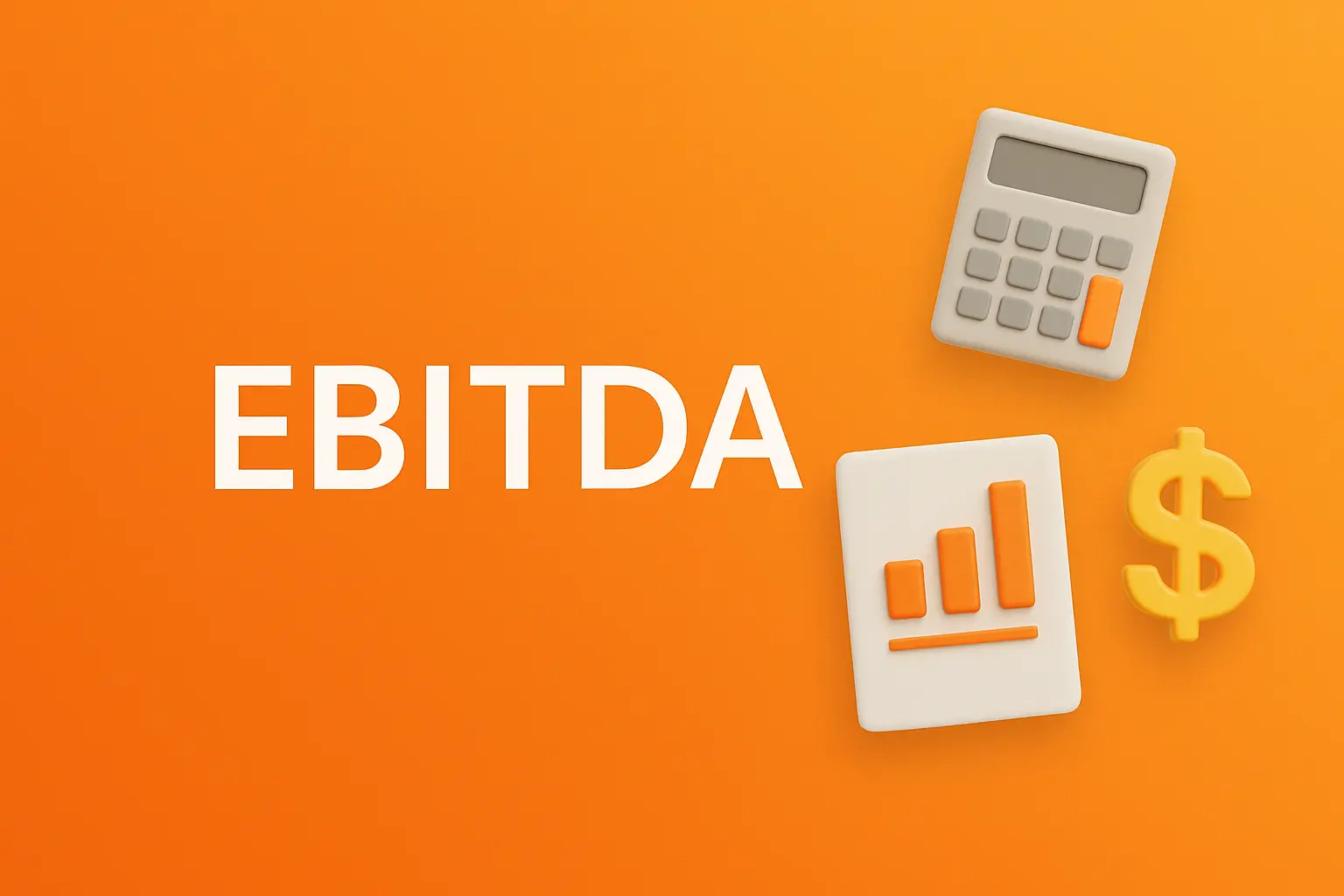
Leave a Reply